
Renault, a French automobile manufacturer, has been associated with Formula One as both team owner and engine manufacturer for various periods since 1977. In 1977, the company entered Formula One as a constructor, introducing the turbo engine to Formula One with its EF1 engine. In 1983, Renault began supplying engines to other teams. Although the Renault team had won races, it withdrew at the end of 1985. Renault engines continued to be raced until 1986.

Nicolas Hülkenberg is a German racing driver, currently competing in Formula One for Haas. In endurance racing, Hülkenberg won the 24 Hours of Le Mans in 2015 with Porsche.

Lotus F1 Team was a British Formula One racing team. The team competed under the Lotus name from 2012 until 2015, following the renaming of the former Renault team based at Enstone in Oxfordshire. The Lotus F1 Team was majority owned by Genii Capital. Lotus F1 was named after its branding partner Group Lotus. The team achieved a race victory and fourth position in the Formula One Constructors' World Championship in their first season under the Lotus title. Lotus F1 achieved 2 race victories in their time on the grid, both courtesy of Kimi Räikkönen. The team was sold back to Renault on 18 December 2015. The Lotus F1 Team name was officially dropped on 3 February 2016, as Renault announced that the team would compete as Renault Sport Formula One Team.

Carlos Sainz Vázquez de Castro is a Spanish racing driver, currently competing in Formula One for Ferrari. Sainz has won four Formula One Grands Prix across 10 seasons.
Haas Formula LLC, competing as MoneyGram Haas F1 Team, is an American-licensed Formula One racing team established by NASCAR Cup Series team co-owner Gene Haas in April 2014. The team originally intended to make its debut at the start of the 2015 season but later elected to postpone their entry until the 2016 season. The team principal is Ayao Komatsu, who replaced Guenther Steiner who served in the role from the team's inception until January 2024.

The 2015 Abu Dhabi Grand Prix was a Formula One motor race held at the Yas Marina Circuit on 29 November 2015. The race was the nineteenth and final round of the 2015 season, and marked the seventh running of the Abu Dhabi Grand Prix as a round of the World Championship since its inception in 1950.
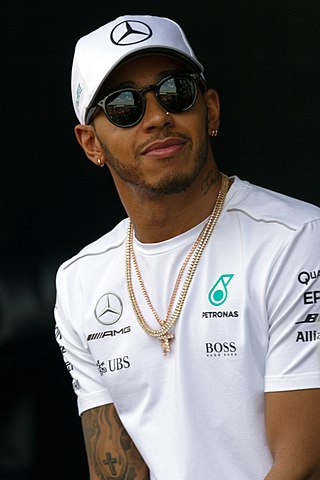
The 2017 FIA Formula One World Championship was the 71st season of Formula One motor racing. It featured the 68th Formula One World Championship, a motor racing championship for Formula One cars which is recognised by the sport's governing body, the Fédération Internationale de l'Automobile (FIA), as the highest class of competition for open-wheel racing cars. Teams and drivers competed in twenty Grands Prix—starting in Australia on 26 March and ending in Abu Dhabi on 26 November—for the World Drivers' and World Constructors' championships.
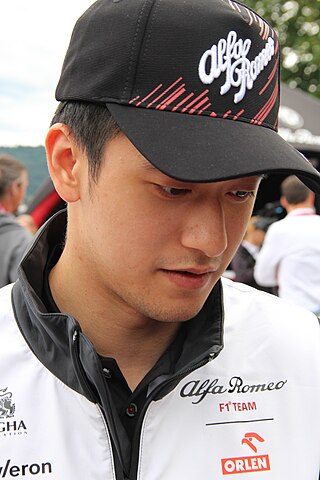
Zhou Guanyu is a Chinese racing driver, currently competing in Formula One for Sauber. Zhou is the only Chinese driver to compete in Formula One.

The 2016 Abu Dhabi Grand Prix was a Formula One motor race held on 27 November 2016 at the Yas Marina Circuit in Abu Dhabi, United Arab Emirates. The race was the twenty-first and final round of the 2016 FIA Formula One World Championship and determined the 2016 World Drivers' Championship. It marked the eighth running of the Abu Dhabi Grand Prix and the eighth time that the race had been run as a World Championship event since the inaugural race in 2009.

The Renault R.S.16 was a Formula One racing car designed by the Renault Sport Formula One Team to compete in the 2016 Formula One season, and marked Renault's return to the sport as a constructor after a five-year absence. The Renault R.S.16 was also the first Renault-badged turbocharged car to compete in the sport since Renault RE60 in 1985.

The 2018 FIA Formula One World Championship was the motor racing championship for Formula One cars and the 69th running of the Formula One World Championship. Formula One is recognised by the governing body of international motorsport, the Fédération Internationale de l'Automobile (FIA), as the highest class of competition for open-wheel racing cars. Drivers and teams competed in twenty-one Grands Prix for the World Drivers' and World Constructors' championship titles.

The 2017 United States Grand Prix was a Formula One motor race held on October 22, 2017, at the Circuit of the Americas in Austin, Texas, United States as the seventeenth round of the 2017 FIA Formula One World Championship. The race marked the forty-seventh running of the United States Grand Prix, the thirty-ninth time that the race was run as a World Championship event since the inaugural season in 1950, and the sixth time that a World Championship round was held at the Circuit of the Americas in Austin, Texas.
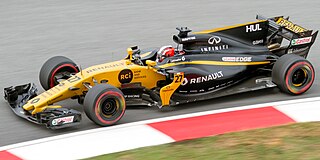
The Renault R.S.17 is a Formula One racing car designed and constructed by the Renault Sport Formula One Team to compete during the 2017 Formula One season. The chassis was designed by Nick Chester, Chris Cooney, Martin Tolliday and Jon Tomlinson with Bob Bell overseeing the design and production of the car as chief technical officer and Rémi Taffin leading the powertrain design. The Renault R.S.17 was the first car designed under Renault's direction since the R31 in 2011.
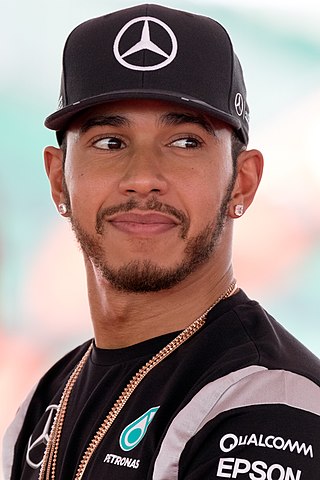
The 2019 FIA Formula One World Championship was the motor racing championship for Formula One cars which marked the 70th running of the Formula One World Championship. It is recognised by the governing body of international motorsport, the Fédération Internationale de l'Automobile (FIA), as the highest class of competition for open-wheel racing cars. Starting in March and ending in December, the championship was contested over twenty-one Grands Prix. Drivers competed for the title of World Drivers' Champion, and teams for the title of World Constructors' Champion. The 2019 championship also saw the running of the 1000th World Championship race, the 2019 Chinese Grand Prix.

The 2018 Abu Dhabi Grand Prix was a Formula One motor race held on 25 November 2018 at the Yas Marina Circuit in Abu Dhabi, United Arab Emirates. The race was the twenty first and final round of the 2018 Formula One World Championship and marked the tenth running of the Abu Dhabi Grand Prix and the tenth time that the race has been run as a World Championship event since the inaugural event in 2009. The race was the last to be officiated by Charlie Whiting as race director as he would die shortly before the next race was held. It was also notable for being the final Grand Prix for Fernando Alonso until his return in 2021.

The 2020 FIA Formula One World Championship was the motor racing championship for Formula One cars which was the 71st running of the Formula One World Championship. It marked the 70th anniversary of the first Formula One World Drivers' Championship. The championship was recognised by the governing body of international motorsport, the Fédération Internationale de l'Automobile (FIA), as the highest class of competition for open-wheel racing cars. Drivers and teams competed for the titles of World Drivers' Champion and World Constructors' Champion, respectively.
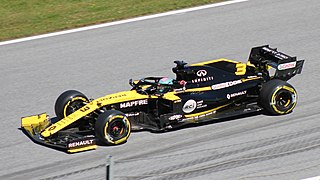
The Renault R.S.19 is a Formula One racing car designed and constructed by the Renault F1 Team to compete during the 2019 FIA Formula One World Championship. The chassis was designed by Nick Chester, Chris Cooney, Martin Tolliday, Simon Virrill and Pete Machin with Marcin Budkowski overseeing the design and production of the car as executive technical director and Rémi Taffin leading the powertrain design. The car was driven by Nico Hülkenberg and Daniel Ricciardo. The car made its competitive debut at the 2019 Australian Grand Prix.
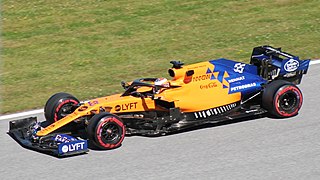
The McLaren MCL34 was a Formula One racing car designed by Pat Fry and constructed by McLaren to compete in the 2019 Formula One World Championship. The car was driven by Carlos Sainz Jr., who joined the team from the Renault Sport F1 Team; and 2018 Formula 2 Championship runner-up Lando Norris. Sainz Jr. and Norris replaced Fernando Alonso and Stoffel Vandoorne, both of whom left the team at the end of the 2018 championship. The MCL34 was powered by a Renault engine, the Renault E-Tech 19, and made its début at the 2019 Australian Grand Prix. The car was considered to be a big improvement compared to its disappointing predecessor, the MCL33, often being the best of the rest in qualifying and race trim behind the three leading teams: Mercedes, Ferrari and Red Bull.

The McLaren MCL35 is a Formula One car that was designed under the direction of James Key and constructed by McLaren to compete in the Formula One World Championship. The car was originally intended to compete in the 2020 season only, but as the championship was heavily disrupted by the COVID-19 pandemic, the lifespan of all 2020 cars was extended into 2021. McLaren produced an upgraded version of the car, the McLaren MCL35M, for the 2021 championship as the team returned to using Mercedes engines. Both variants of the car were considered competitive and the team's results improved considerably during the two seasons it was used in, with McLaren regularly the third-fastest team and significantly closer to the leading teams than had been the case since the turbo-hybrid era began in 2014.

The 2020 Abu Dhabi Grand Prix was a Formula One motor race held on 13 December 2020 at the Yas Marina Circuit in Abu Dhabi, United Arab Emirates. The race was the seventeenth and final race of the 2020 Formula One World Championship. Red Bull driver Max Verstappen won the race and led every lap from pole position, followed by Mercedes drivers Valtteri Bottas and Lewis Hamilton who completed the podium. Red Bull Racing got their first victory at Yas Marina in seven years. McLaren secured third place in the Constructors' Championship which saw them score their highest finish in the Constructors' Championship since 2012. This also meant that for the first time since 2015, a team other than Mercedes, Ferrari, and Red Bull finished in the top three in the Constructors' Championship. This race also marked the last time the original configuration of the Yas Marina circuit which had been used since the first Grand Prix at the venue in 2009 was used by Formula One. Grands Prix would be held on a revised layout from 2021 onwards.















